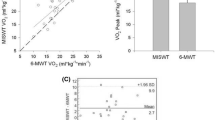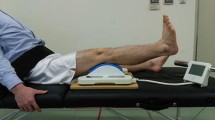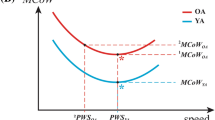Abstract
The preferred walking speed is a common measure of mobility that declines with age and has been related to maximal oxygen uptake (V̇O2,max). The present study determined whether this decline is associated with a higher percentage of the ventilatory threshold in older adults walking at their preferred speed. We compared the preferred walking speed and V̇O2 at this speed in relation to both V̇O2,max and V̇O2 corresponding to the ventilatory threshold (T VE) in healthy, physically active sexagenarians (G65, n=10) and octogenarians (G80, n=10) walking on a treadmill. The preferred walking speed was lower in G80 (1.16±0.09 m·s−1) than in G65 (1.38±0.09 m·s−1; P<0.001). Energy expenditure and the energy cost of walking at the preferred walking speed were not significantly different between the two groups. G80 subjects exhibited significantly higher fractions of V̇O2,max (60.8±8.0%) and T VE (74.2±7.9%) at the preferred walking speed than G65 (42.9±5.0 and 53.2±5.7% respectively; P<0.001). Multiple regression analysis showed that the fraction of T VE was the main determinant, with a small contribution of height, in the decline in the preferred walking speed in healthy and active elderly subjects (R 2=64%; P<0.001). These findings show that with age, walking at the preferred speed requires a higher fraction of T VE. This increase in the relative physiological effort at preferred walking speed could explain the reduction in this gait speed in healthy older subjects.



Similar content being viewed by others
References
Alexander NB (1996) Gait disorders in older adults. J Am Geriatr Soc 44:434–451
Babcock MA, Paterson DH, Cunningham DA (1992) Influence of ageing on aerobic parameters determined from a ramp test. Eur J Appl Physiol 65:138–143
Bassey EJ (1985) Benefits of exercise in the elderly. In: Isaacs B (ed) Recent advances in geriatric medicine, Vol. 3. Churchill Livingstone, Edinburgh, pp 39–112
Bassey EJ, Fentem PH, MacDonald IC, Scriven PM (1976) Self-paced walking as a method for exercise testing in elderly and young men. Clin Sci Mol Med Suppl 51:609–612
Bassey EJ, Macdonald IA, Patrick JM (1982) Factors affecting the heart rate during self-paced walking. Eur J Appl Physiol 48:105–115
Beaver WL, Wasserman K, Whipp BJ (1986) A new method for detecting anaerobic threshold by gas exchange. J Appl Physiol 60:2020–2027
Bendall MJ, Bassey EJ, Pearson MB (1989) Factors affecting walking speed of elderly people. Age Ageing 18:327–332
Buchfuhrer MJ, Hansen JE, Robinson TE, Sue DY, Wasserman K, Whipp BJ (1983) Optimizing the exercise protocol for cardiopulmonary assessment. J Appl Physiol 55:1558–1564
Buchner DM, Cress ME, Esselman PC, Margherita AJ, de Lateur BJ, Campbell AJ, Wagner EH (1996) Factors associated with changes in gait speed in older adults. J Gerontol A Biol Sci Med Sci 51:M297–M302
Buskirk ER, Hodgson JL (1987) Age and aerobic power: the rate of change in men and women. Fed Proc 46:1824–1829
Conley KE, Esselman PC, Jubrias SA, Cress ME, Inglin B, Mogadam C, Schoene RB (2000) Ageing, muscle properties and maximal O2 uptake rate in humans. J Physiol (Lond) 526:211–217
Cunningham DA, Rechnitzer PA, Pearce ME, Donner AP (1982) Determinants of self-selected walking pace across ages 19 to 66. J Gerontol 37:560–564
Cunningham DA, Nancekievill EA, Paterson DH, Donner AP, Rechnitzer PA (1985) Ventilation threshold and aging. J Gerontol 40:703–707
Folstein MF, Folstein SE, McHugh PR (1975) “Mini-mental state”. A practical method for grading the cognitive state of patients for the clinician. J Psychiatr Res 12:189–198
Hawkins SA, Marcell TJ, Victoria Jaque S, Wiswell RA (2001) A longitudinal assessment of change in V̇O2,max and maximal heart rate in master athletes. Med Sci Sports Exerc 33:1744–1750
Heath GW, Hagberg JM, Ehsani AA, Holloszy JO (1981) A physiological comparison of young and older endurance athletes. J Appl Physiol 51:634–640
Hepple RT, Hagen JL, Krause DJ, Jackson CC (2003) Aerobic power declines with aging in rat skeletal muscles perfused at matched convective O2 delivery. J Appl Physiol 94:744–751
Higginbotham MB, Morris KG, Williams RS, Coleman RE, Cobb FR (1986) Physiologic basis for the age-related decline in aerobic work capacity. Am J Cardiol 57:1374–1379
Himann JE, Cunningham DA, Rechnitzer PA, Paterson DH (1988) Age-related changes in speed of walking. Med Sci Sports Exerc 20:161–166
Hortobagyi T, Mizelle C, Beam S, DeVita P (2003) Old adults perform activities of daily living near their maximal capabilities. J Gerontol A Biol Sci Med Sci 58:M453–M460
Jackson AS, Beard EF, Wier LT, Ross RM, Stuteville JE, Blair SN (1995) Changes in aerobic power of men, ages 25–70 yr. Med Sci Sports Exerc 27:113–120
Leiper CI, Craik RL (1991) Relationships between physical activity and temporal-distance characteristics of walking in elderly women. Phys Ther 71:791–803
Malatesta D, Simar D, Dauvillier Y, Candau R, Borrani F, Prefaut C, Caillaud C (2003) Energy cost of walking and gait instability in healthy 65- and 80-year-olds. J Appl Physiol 95:2248–2256
Martin PE, Rothstein DE, Larish DD (1992) Effects of age and physical activity status on the speed-aerobic demand relationship of walking. J Appl Physiol 73:200–206
Murray MP, Kory RC, Clarkson BH (1969) Walking patterns in healthy old men. J Gerontol 24:169–178
Neder JA, Nery LE, Castelo A, Andreoni S, Lerario MC, Sachs A, Silva AC, Whipp BJ (1999) Prediction of metabolic and cardiopulmonary responses to maximum cycle ergometry: a randomised study. Eur Respir J 14:1304–1313
Paterson DH, Cunningham DA, Koval JJ, St Croix CM (1999) Aerobic fitness in a population of independently living men and women aged 55–86 years. Med Sci Sports Exerc 31:1813–1820
Pimentel AE, Gentile CL, Tanaka H, Seals DR, Gates PE (2003) Greater rate of decline in maximal aerobic capacity with age in endurance-trained than in sedentary men. J Appl Physiol 94:2406–2413
Pollock ML, Foster C, Knapp D, Rod JL, Schmidt DH (1987) Effect of age and training on aerobic capacity and body composition of master athletes. J Appl Physiol 62:725–731
Pollock ML, Mengelkoch LJ, Graves JE, Lowenthal DT, Limacher MC, Foster C, Wilmore JH (1997) Twenty-year follow-up of aerobic power and body composition of older track athletes. J Appl Physiol 82:1508–1516
Posner JD, Gorman KM, Klein HS, Cline CJ (1987) Ventilatory threshold: measurement and variation with age. J Appl Physiol 63:1519–1525
Schultz AB, Alexander NB, Ashton-Miller JA (1992) Biomechanical analyses of rising from a chair. J Biomech 25:1383–1391
Tanaka H, Desouza CA, Jones PP, Stevenson ET, Davy KP, Seals DR (1997) Greater rate of decline in maximal aerobic capacity with age in physically active vs. sedentary healthy women. J Appl Physiol 83:1947–1953
Thomas SG, Woodhouse LJ, Pagura SM, Ezzat S (2002) Ventilation threshold as a measure of impaired physical performance in adults with growth hormone excess. Clin Endocrinol (Oxf) 56:351–358
Toth MJ, Gardner AW, Ades PA, Poehlman ET (1994) Contribution of body composition and physical activity to age-related decline in peak V̇O2 in men and women. J Appl Physiol 77:647–652
Voorrips LE, Ravelli AC, Dongelmans PC, Deurenberg P, Van Staveren WA (1991) A physical activity questionnaire for the elderly. Med Sci Sports Exerc 23:974–979
Wasserman K, Whipp BJ, Koyl SN, Beaver WL (1973) Anaerobic threshold and respiratory gas exchange during exercise. J Appl Physiol 35:236–243
Waters RL, Hislop HJ, Perry J, Thomas L, Campbell J (1983) Comparative cost of walking in young and old adults. J Orthop Res 1:73–76
Zhang JG, Ohta T, Ishikawa-Takata K, Tabata I, Miyashita M (2003) Effects of daily activity recorded by pedometer on peak oxygen consumption (V̇O2,max), ventilatory threshold and leg extension power in 30- to 69-year-old Japanese without exercise habit. Eur J Appl Physiol 90:109–113
Acknowledgements
The authors wish to thank Nicola Maffiuletti for helpful suggestions and criticism, the staff of the “Service d’Exploration Fonctionnelle Respiratoire” and the subjects for their participation.
Author information
Authors and Affiliations
Corresponding author
Rights and permissions
About this article
Cite this article
Malatesta, D., Simar, D., Dauvilliers, Y. et al. Aerobic determinants of the decline in preferred walking speed in healthy, active 65- and 80-year-olds. Pflugers Arch - Eur J Physiol 447, 915–921 (2004). https://doi.org/10.1007/s00424-003-1212-y
Received:
Revised:
Accepted:
Published:
Issue Date:
DOI: https://doi.org/10.1007/s00424-003-1212-y




